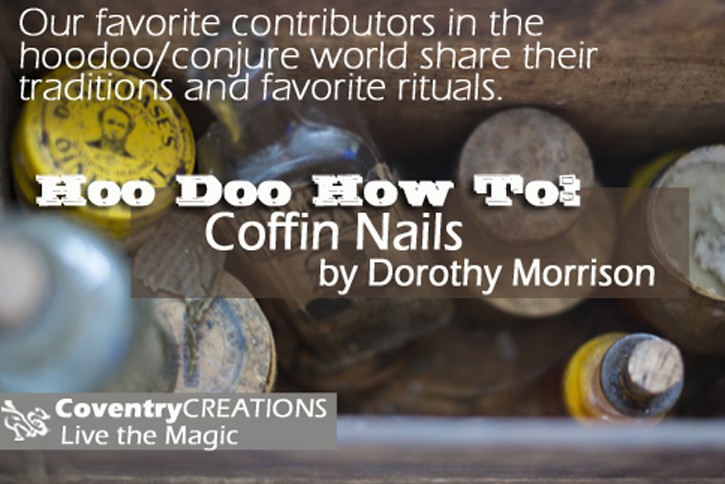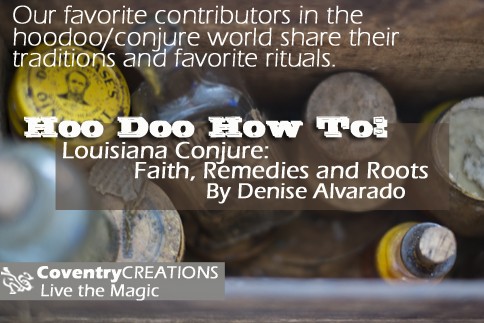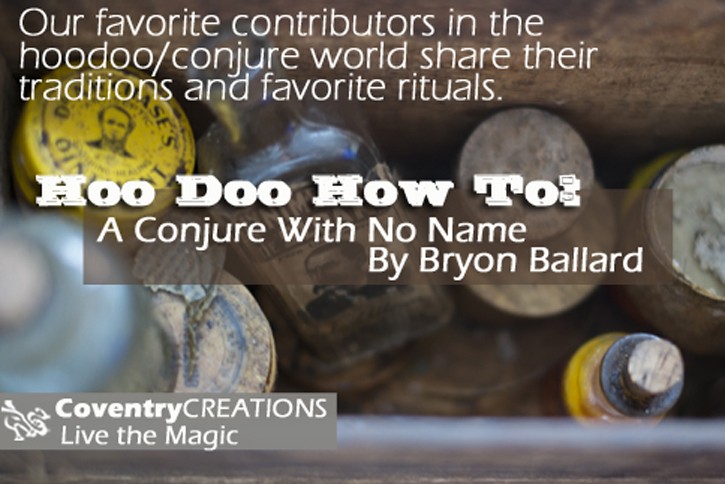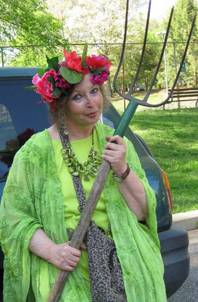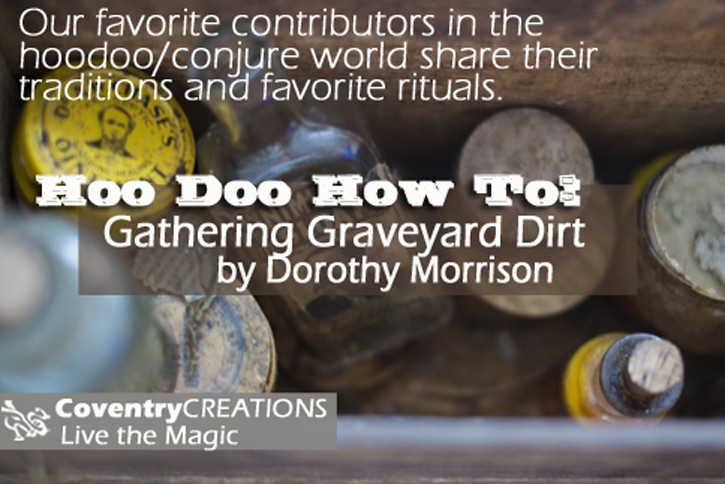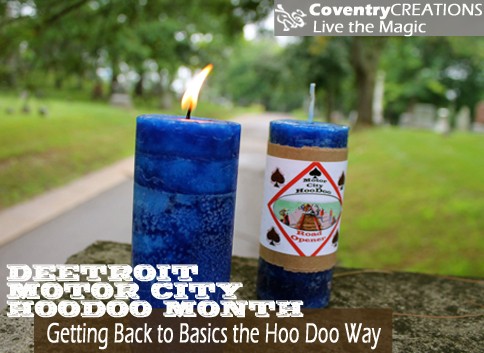Louisiana Conjure: Faith, Remedies and Roots

by Denise Alvarado
Denise Alvarado is a New Orleans-born, native Creole raised in the rich culture of New Orleans, Louisiana. She has studied indigenous healing traditions from a personal, professional and academic perspective for over four decades. She is the author of numerous books about southern conjure, including the The Conjurer's Guide to St. Expedite, The Voodoo Hoodoo Spellbook, the Hoodoo Almanacs, Workin' in da Boneyard, Hoodoo and Conjure New Orleans, Crossroads Mamas 2015 Spiritual Baths for Every Occasion, the Voodoo Doll Spellbook, Voodoo Dolls in Magick and Ritual and more. Her provocative artwork has been featured on several
television shows including National Geographic's Taboo, The Originals, and Blue Bloods, as well as in several books by other authors. She is a rootworker in the Louisiana Hoodoo tradition, a spiritual artist, and teacher of southern conjure at Crossroads University, www.crossroadsuniversity.com. Visit her websites: http://www.creolemoon.com and www.voodoomuse.org for a little sweet tea and conjure.
In the olden days, it was commonplace for women to have a variety of animal, mineral and botanical elements within reach so as to be able to tend to any number of conditions presented. Women were the primary healers in the family; as the kitchen was their domain, so was the doctoring. Of course, there were also men who worked roots, but learning about the healing properties of herbs and roots were just part of women’s work in the home.
The materia medica of the typical household would have consisted of animal substances such as fat, milk, bones, bugs and excrement (I know, yuck, but such was the case). Mineral and chemical substances included vinegar, bluestone, sulphur, Vaseline, camphor, turpentine, Epsom salts, baking soda, gasoline, ammonia, snuff, coal oil and kerosene. Most had gardens or knew the local flora and fauna well enough to have a variety of natural medicines on hand for rootdoctoring. All of these things were used to make ointments, compresses, poultices, decoctions, teas, baths, infusions, tonics, liniments and conjury. You wouldn’t hear Mama say she was conjuring anything; usually, she was just “fixin’” something.
While many families had someone who was knowledgeable of folk remedies and cures and even conjure – that being the realm of the supernatural – there are actually three categories of healers in Louisiana: the reméde man or woman, the traiteur, and the rootworker (also known as rootdoctor, hoodoo or gris gris man or woman). The reméde man treats natural physical ailments with plants, medicine from the drugstore and domestic remedies. The traiteur heals natural and spiritual conditions with prayer, laying of hands and charms. They claim to have God-given powers that allow them to heal through faith. The rootworker or hoodoo cures and creates unnatural diseases and conditions through spells, gris gris, and a variety of charms and tricks.
True to the very essence of hoodoo and rootwork, if an ingredient was needed that wasn’t on hand, a substitution was made in all of the above cases. Many family recipes served multiple purposes and for the most part the goal was the alleviation of symptoms as opposed to a cure; although, a cure at any time is always a welcomed event.
Often there is prayer involved in serious cases. Faith combined with the spirit of the medicine served and continues to serve to heal many people who could not afford a conventional doctor.
Curin’ takes on several forms, including poultices, compresses, tinctures and infusions. Most commonly a poultice is used to apply an external herbal cure. In general, a homemade poultice is made by mashing herbs and other ingredients with warm water or natural oils to make a paste. The paste is then applied directly to the skin and covered with a piece of clean cloth. A compress is made similarly except the raw, prepared materials are applied to a cloth which is then applied to the affected area. Tinctures and infusions were often applied as compresses. Poultices and compresses are reapplied every 3 to 4 hours or when the material had dried out.
To make a slippery elm and thyme poultice for the treatment of boils, for example, grind up fresh thyme leaves using a mortar and pestle, then cover with boiling water. Pour off the excess liquid and add powdered slippery elm bark. It should be the consistency of a paste. Apply directly to the boil and cover with gauze. Keep it covered for several hours.
Another common form of medicine is the liniment. They are simple to make, keep well and offer instant relief for pain, inflamed muscles, circulation problems, arthritis, bruises and sprains. They can also be used as antiseptics depending on the botanicals used. They can be created to provide warming or cooling. Herbs and spices like cayenne pepper, black pepper and ginger can be added to stimulate blood circulation and assist with arthritis, pain, stiffness, and conditions aggravated by exertion or cold weather. Cooling ingredients such as peppermint or menthol crystals are ideal for inflammation and swelling, and areas that are “hot” due to sprains, bruises, and other injuries.
Liniments are made in a base of alcohol, witch hazel, or oil. The base functions as a carrier for the other herbal ingredients to effectively penetrate into the affected area and provide relief.
For example, an old folk liniment to treat a chest cold consists of a concoction of turpentine, oil of cedar, camphor, and Vaseline which is then smeared on the chest area. To treat rheumatism, a preparation can be made from Pokeberry root (Phytolacca americana) mixed with sweet almond oil, mineral oil or lard.
Here are some more examples of old time remedies for a number of conditions.
COLDS
Internal Remedies
-
A tea of magnolia, sassafras and citronella.
-
An infusion of elderberry flowers.
-
The bark of a peach tree boiled down and turned to the East.
-
A syrup made of honey, soda, olive oil and the crushed grains of coral tree.
-
A tonic called Whiskey Camfré, which consists of whiskey poured over crushed camphor and bottled to be taken a spoonful at a time.
External Remedies
MINOR CUTS, SORES AND ABRASIONS
-
A poultice of hot milk.
-
A poultice of brown sugar and soap.
-
A poultice of sugar and corn husks.
-
A poultice of snuff and honey (also good for bee stings).
-
A poultice of bread and milk.
INSECT BITES AND BEE STINGS
-
Chew a plantain leaf and don’t swallow it. Spit it out and put on the insect bite and cover with gauze or a Band-Aid.
-
Clean mud applied directly to a bite. Does not have to be covered.
-
A sliced raw onion held directly on a bite or sting is said to bring quick relief.
SORE THROAT
-
Gargle with a decoction made from the roots of the blackberry bush.
-
Gargle with a decoction made from persimmon tree blossoms.
-
Rub the neck with Whiskey Camfré.
-
Drink an infusion of boiled flies or chicken gizzards.
BLEEDING
-
A handful of spider webs placed on the affected area will stop bleeding. Check out this article for an interesting read about this: A Mess of Cobwebs Makes a Believer out of Doc Miller.
-
Wear a key on a string around the neck to stop nosebleeds.
HIGH BLOOD PRESSURE
-
A tea made from yellow root (goldenseal).
-
Eat 2 cloves of garlic daily.
-
A tea made from 2-3 bay leaves (also relieves migraines).
In addition to the use of household items and plants in curing, there are superstitions and old wives tales associated with certain practices. Magic formulas, protective amulets, faith healing, and prayer are used in Louisiana folk medicine, as well as conjure, and often the lines between the two are blurred. For example:
-
Wearing a strand of amber beads will stop a toothache.
-
Making the sign of the cross with a black cat’s tail over a sty will make the sty disappear.
-
Two matches crossed on a person’s head will make a headache go away.
-
A red string tied around the little finger will stop a nosebleed.
-
A toad placed on the head will transfer a headache to the toad. When the toad dies, the headache will disappear.
-
Lie on a bed of cool willow leaves to get rid of a fever. Once the leaves are warm, it is said the fever has been transferred into the leaves and they must be discarded.
-
To cure a burn, pass your hand over the burn and say nine times, “When Jacquot was crossing the sea someone told him: it kills fire, it kills frost, in the name of the Father and Son and Holy Ghost.”
In the past, as in the present, protective amulets are numerous and consist of plants and animals. Some of the items used as amulets include:
FORMULA FOR PINE PITCH OINTMENT
Pine pitch is a very effective folk remedy with numerous uses. It helps to dislodge splinters and bring boils to a head. It is good for rheumatism due to its anti-inflammatory properties. It can be used as an external treatment for burns and sores. It can be used as a glue, sealant and as fuel. The uses for pine pitch are endless, really.
To make pine pitch ointment, gather some pine sap. Fill up a mason jar about 1/3 full. The softest sap goes on the bottom and break up the harder pieces to the smallest size possible. Don’t use your mortar and pestle for this unless you have one you use only for pine resin as it is incredibly sticky.
Fill the jar with olive oil and give the jar a little shake to mix it up. Set the jar in a pan of water or a double boiler and heat on low heat until the pitch is dissolved. Carefully stir the pine oil.
Next add the beeswax and stir. The ratio for making the ointment is one part pitch to 2 parts oil and beeswax. When all is melted, pour into smaller containers and allow it to harden. Voila! You should have enough pine pitch salve to last a very long time.
Here are some folk remedies using pine pitch:
-
To prevent infection of wounds, get tallow (preferably mutton tallow), mix it with pine pitch, and apply. The pitch has antiseptic powers.
-
For colds, inhale several times a day the smoke from a shovel of red hot colds, covered by one layer of lightwood splinters from pitchy pine stumps, one layer of rags to hold in flames and keep the fire smoldering, a light sprinkling of tar and of turpentine distilled from pinewood of first two layers.
References
-Clark, Joseph D. "North Carolina Popular Beliefs and Superstitions." North Carolina Folklore, 18 (1970), 1-66.
Mellinger, Marie B. "Medicine of the Cherokees." Foxfire. 1, no. 3 (1967), 13-20; 65-72.
-Sexton, R. (1992). Cajun and Creole Treaters: Magico-Religious Folk Healing in French Louisiana, Western Folklore Vol. 51, No. 3/4 (Jul. - Oct., 1992), pp. 237-248
-Swett, J. (2009) French Louisiana Traiteurs. Retrieved from http://www.louisianafolklife.org/LT/Articles_Essays/LFMtraiteurs.html
To learn more about Southern folk culture on a formal basis, please visit crossroadsuniversity.com.
Copyright 2015 Denise Alvarado, All rights reserved worldwide.

